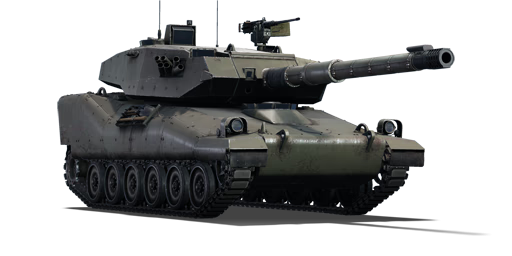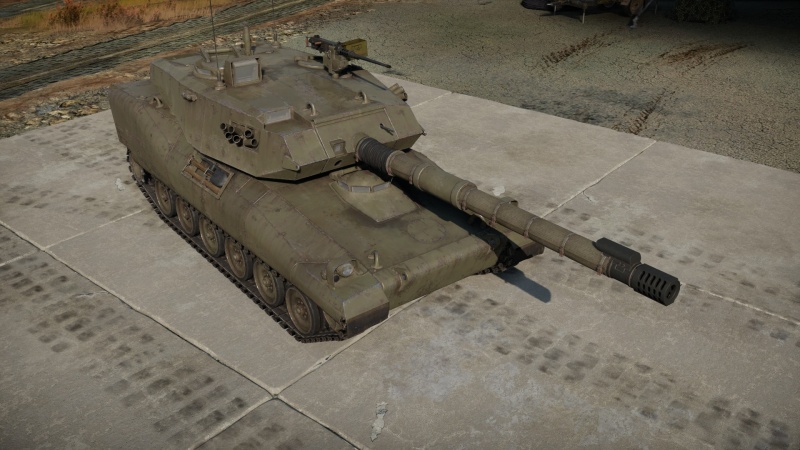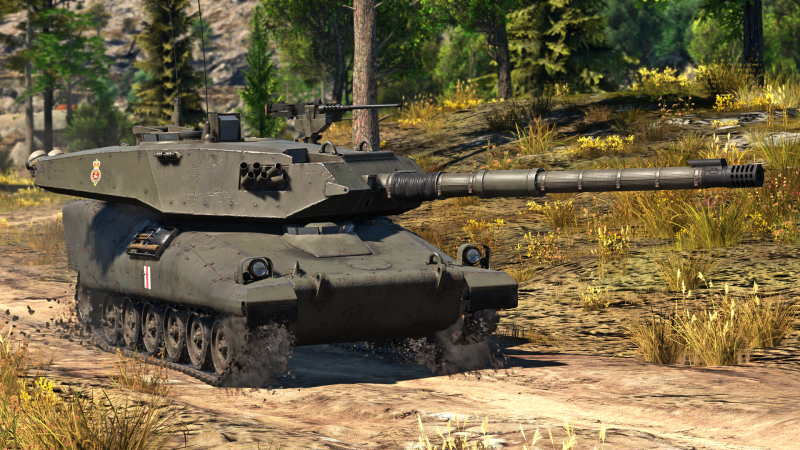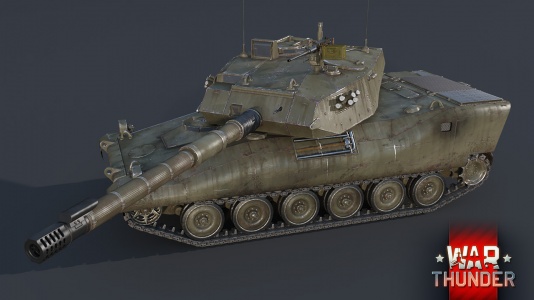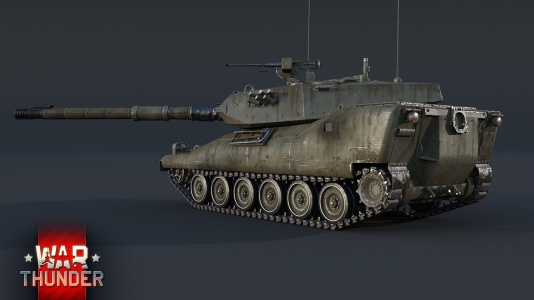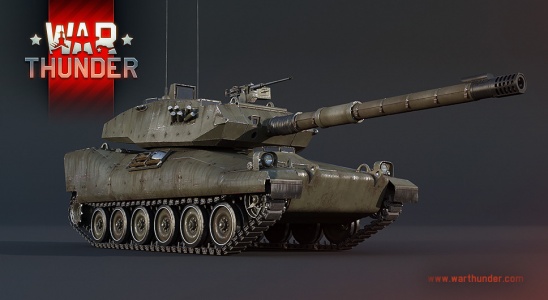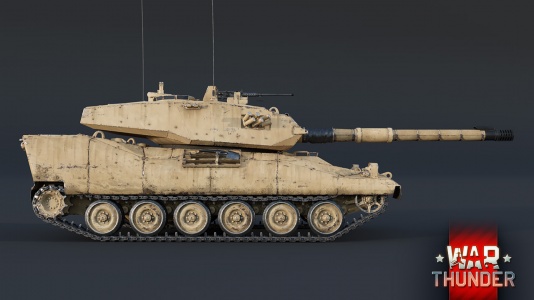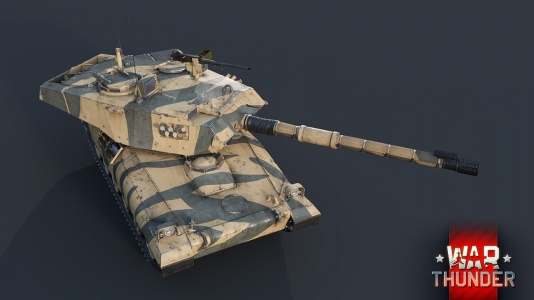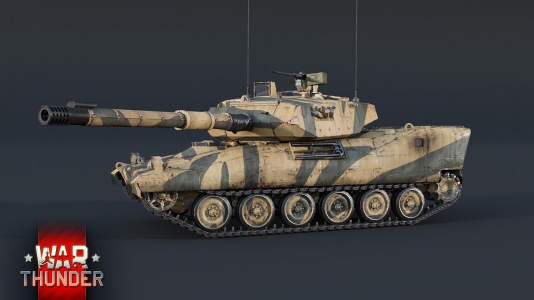Difference between revisions of "VFM5"
(→Main armament: Filled in missing ammo rack usage information.) (Tag: Visual edit) |
(→Ammunition: Converted to transclusion) |
||
| (24 intermediate revisions by 10 users not shown) | |||
| Line 1: | Line 1: | ||
| − | {{Specs-Card|code=uk_vfm_5}} | + | {{Specs-Card |
| + | |code=uk_vfm_5 | ||
| + | |images={{Specs-Card-Image|GarageImage_{{PAGENAME}}.jpg|ArtImage_{{PAGENAME}}.png}} | ||
| + | }} | ||
== Description == | == Description == | ||
<!-- ''In the description, the first part should be about the history of the creation and combat usage of the vehicle, as well as its key features. In the second part, tell the reader about the ground vehicle in the game. Insert a screenshot of the vehicle, so that if the novice player does not remember the vehicle by name, he will immediately understand what kind of vehicle the article is talking about.'' --> | <!-- ''In the description, the first part should be about the history of the creation and combat usage of the vehicle, as well as its key features. In the second part, tell the reader about the ground vehicle in the game. Insert a screenshot of the vehicle, so that if the novice player does not remember the vehicle by name, he will immediately understand what kind of vehicle the article is talking about.'' --> | ||
| − | |||
| − | |||
The '''{{Specs|name}}''' is a rank {{Specs|rank}} British light tank {{Battle-rating}}. It was introduced in [[Update "New Power"]]. | The '''{{Specs|name}}''' is a rank {{Specs|rank}} British light tank {{Battle-rating}}. It was introduced in [[Update "New Power"]]. | ||
== General info == | == General info == | ||
=== Survivability and armour === | === Survivability and armour === | ||
| + | {{Specs-Tank-Armour}} | ||
<!-- ''Describe armour protection. Note the most well protected and key weak areas. Appreciate the layout of modules as well as the number and location of crew members. Is the level of armour protection sufficient, is the placement of modules helpful for survival in combat? If necessary use a visual template to indicate the most secure and weak zones of the armour.'' --> | <!-- ''Describe armour protection. Note the most well protected and key weak areas. Appreciate the layout of modules as well as the number and location of crew members. Is the level of armour protection sufficient, is the placement of modules helpful for survival in combat? If necessary use a visual template to indicate the most secure and weak zones of the armour.'' --> | ||
| − | + | The VFM5 has little to no armour protection from anything larger than 7.62 mm rounds, the M2 .50 cal being able to penetrate its sides. The most protected section of the tank is the front of the hull towards the more extreme angles around the driver's ports, which is up to 160 mm of effective thickness, however this is halved by APFSDS, not that it would matter either way. HEATFS is even more effective, the thickness against chemical rounds dropping to approximately 23 mm. | |
| + | |||
| + | The tank can survive a shot, however shots to the turret have a higher chance, as long as the spalling created by the shell is blocked by the cannon breech. Shots to the left side of the turret (or the right side looking front-on) will likely detonate the ready-rack ammunition. Side shots can be survived as long as they are to the hull due to large amounts of empty space. To increase your chance of survival of side shots, a player should take no more than 30 rounds to ensure the room below the turret is ammunition-free. As one would expect from a tank of this type, taking shots should not be attempted under any circumstances. | ||
{| class="wikitable" | {| class="wikitable" | ||
| Line 22: | Line 26: | ||
| 25.4 mm + 6.35 ''Upper''<br>44 mm ''Lower'' ||25.4 mm||5 - 25.4 mm | | 25.4 mm + 6.35 ''Upper''<br>44 mm ''Lower'' ||25.4 mm||5 - 25.4 mm | ||
|- | |- | ||
| − | | Turret || 50.8 mm (37-43°) ''Turret front'' <br>38.1 mm (37-43°) ''Gun mantlet'' | + | | Turret || 50.8 mm (37-43°) ''Turret front'' <br>38.1 mm (37-43°) ''Gun mantlet'' |
| − | 25.4 mm ''Gunner'' ''Optics'' | + | 25.4 mm ''Gunner'' ''Optics'' |
|38.1 mm + 6.35 mm||12.7 mm +12.7 mm||25.4 mm | |38.1 mm + 6.35 mm||12.7 mm +12.7 mm||25.4 mm | ||
|- | |- | ||
| Line 32: | Line 36: | ||
|} | |} | ||
| − | + | === Mobility === | |
| − | <!-- | + | {{Specs-Tank-Mobility}} |
| + | <!-- ''Write about the mobility of the ground vehicle. Estimate the specific power and manoeuvrability, as well as the maximum speed forwards and backwards.'' --> | ||
| + | |||
| + | {{tankMobility|abMinHp=868|rbMinHp=495}} | ||
| − | === | + | === Modifications and economy === |
| − | + | {{Specs-Economy}} | |
== Armaments == | == Armaments == | ||
| + | {{Specs-Tank-Armaments}} | ||
=== Main armament === | === Main armament === | ||
| + | {{Specs-Tank-Weapon|1}} | ||
<!-- ''Give the reader information about the characteristics of the main gun. Assess its effectiveness in a battle based on the reloading speed, ballistics and the power of shells. Do not forget about the flexibility of the fire, that is how quickly the cannon can be aimed at the target, open fire on it and aim at another enemy. Add a link to the main article on the gun: <code><nowiki>{{main|Name of the weapon}}</nowiki></code>. Describe in general terms the ammunition available for the main gun. Give advice on how to use them and how to fill the ammunition storage.'' --> | <!-- ''Give the reader information about the characteristics of the main gun. Assess its effectiveness in a battle based on the reloading speed, ballistics and the power of shells. Do not forget about the flexibility of the fire, that is how quickly the cannon can be aimed at the target, open fire on it and aim at another enemy. Add a link to the main article on the gun: <code><nowiki>{{main|Name of the weapon}}</nowiki></code>. Describe in general terms the ammunition available for the main gun. Give advice on how to use them and how to fill the ammunition storage.'' --> | ||
{{main|LRF (105 mm)}} | {{main|LRF (105 mm)}} | ||
| − | |||
{| class="wikitable" style="text-align:center" width="100%" | {| class="wikitable" style="text-align:center" width="100%" | ||
| Line 53: | Line 61: | ||
|- | |- | ||
! ''Arcade'' | ! ''Arcade'' | ||
| − | | rowspan="2" | 41 || rowspan="2" | -10°/+20° || rowspan="2" | ±180° || rowspan="2" | Two-plane || | + | | rowspan="2" | 41 || rowspan="2" | -10°/+20° || rowspan="2" | ±180° || rowspan="2" | Two-plane || 38.1 || 52.7 || 64.0 || 70.8 || 75.3 || rowspan="2" | 8.71 || rowspan="2" | 7.70 || rowspan="2" | 7.10 || rowspan="2" | 6.70 |
|- | |- | ||
! ''Realistic'' | ! ''Realistic'' | ||
| − | | | + | | 23.8 || 28.0 || 34.0 || 37.6 || 40.0 |
|- | |- | ||
|} | |} | ||
==== Ammunition ==== | ==== Ammunition ==== | ||
| − | { | + | {{:LRF (105 mm)/Ammunition|M456A2, M393A2, C76A1, DM33}} |
| − | |||
| − | |||
| − | |||
| − | |||
| − | |||
| − | | | ||
| − | |||
| − | |||
| − | |||
| − | |||
| − | |||
| − | |||
| − | |||
| − | |||
| − | |||
| − | |||
| − | |||
| − | |||
| − | |||
| − | |||
| − | |||
| − | |||
| − | |||
| − | |||
| − | |||
| − | |||
| − | |||
| − | |||
| − | |||
| − | |||
| − | |||
| − | |||
| − | |||
| − | |||
| − | |||
| − | |||
| − | |||
| − | |||
| − | |||
| − | |||
| − | |||
| − | |||
| − | |||
| − | |||
==== [[Ammo racks]] ==== | ==== [[Ammo racks]] ==== | ||
| − | + | [[File:Ammoracks_{{PAGENAME}}.png|right|thumb|x250px|[[Ammo racks]] of the {{PAGENAME}}]] | |
| − | <!-- '''Last updated: 2. | + | <!-- '''Last updated: 2.17.0.126''' --> |
{| class="wikitable" style="text-align:center" | {| class="wikitable" style="text-align:center" | ||
|- | |- | ||
| Line 120: | Line 84: | ||
! Visual<br>discrepancy | ! Visual<br>discrepancy | ||
|- | |- | ||
| − | | '''41''' || | + | | '''41''' || 36 ''(+5)'' || 30 ''(+11)'' || 19 ''(+22)'' || 8 ''(+33)'' || 1 ''(+40)'' || No |
|- | |- | ||
|} | |} | ||
| − | |||
=== Machine guns === | === Machine guns === | ||
| + | {{Specs-Tank-Weapon|2}} | ||
| + | {{Specs-Tank-Weapon|3}} | ||
<!-- ''Offensive and anti-aircraft machine guns not only allow you to fight some aircraft but also are effective against lightly armoured vehicles. Evaluate machine guns and give recommendations on its use.'' --> | <!-- ''Offensive and anti-aircraft machine guns not only allow you to fight some aircraft but also are effective against lightly armoured vehicles. Evaluate machine guns and give recommendations on its use.'' --> | ||
{{main|M2HB (12.7 mm)|L8A2 (7.62 mm)}} | {{main|M2HB (12.7 mm)|L8A2 (7.62 mm)}} | ||
| Line 144: | Line 109: | ||
! Mount !! Capacity (Belt) !! Fire rate !! Vertical !! Horizontal | ! Mount !! Capacity (Belt) !! Fire rate !! Vertical !! Horizontal | ||
|- | |- | ||
| − | | Coaxial || 4, | + | | Coaxial || 4,600 (200) || 600 || N/A || N/A |
|- | |- | ||
|} | |} | ||
| Line 151: | Line 116: | ||
<!-- ''Describe the tactics of playing in the vehicle, the features of using vehicles in the team and advice on tactics. Refrain from creating a "guide" - do not impose a single point of view but instead give the reader food for thought. Describe the most dangerous enemies and give recommendations on fighting them. If necessary, note the specifics of the game in different modes (AB, RB, SB).'' --> | <!-- ''Describe the tactics of playing in the vehicle, the features of using vehicles in the team and advice on tactics. Refrain from creating a "guide" - do not impose a single point of view but instead give the reader food for thought. Describe the most dangerous enemies and give recommendations on fighting them. If necessary, note the specifics of the game in different modes (AB, RB, SB).'' --> | ||
''Describe the tactics of playing in the vehicle, the features of using vehicles in the team and advice on tactics. Refrain from creating a "guide" - do not impose a single point of view but instead give the reader food for thought. Describe the most dangerous enemies and give recommendations on fighting them. If necessary, note the specifics of the game in different modes (AB, RB, SB).'' | ''Describe the tactics of playing in the vehicle, the features of using vehicles in the team and advice on tactics. Refrain from creating a "guide" - do not impose a single point of view but instead give the reader food for thought. Describe the most dangerous enemies and give recommendations on fighting them. If necessary, note the specifics of the game in different modes (AB, RB, SB).'' | ||
| − | |||
| − | |||
| − | |||
| − | |||
| − | |||
| − | |||
| − | |||
| − | |||
| − | |||
| − | |||
| − | |||
| − | |||
| − | |||
| − | |||
| − | |||
| − | |||
| − | |||
| − | |||
| − | |||
| − | |||
| − | |||
| − | |||
| − | |||
| − | |||
| − | |||
| − | |||
| − | |||
| − | |||
| − | |||
| − | |||
| − | |||
| − | |||
| − | |||
| − | |||
| − | |||
| − | |||
| − | |||
| − | |||
| − | |||
| − | |||
| − | |||
=== Pros and cons === | === Pros and cons === | ||
| Line 200: | Line 124: | ||
* Equips the renowned 105 mm L7 cannon | * Equips the renowned 105 mm L7 cannon | ||
* Good mobility | * Good mobility | ||
| + | * 10X gunner zoom is good for sniping | ||
'''Cons:''' | '''Cons:''' | ||
* Lightly armoured | * Lightly armoured | ||
| + | * Stock HEATFS, a bad thing considering enemies can be well-protected against chemical warheads | ||
| + | * Non-sabot APHE rounds from most SPAA's will ricochet off the hull into the lower turret, damaging or knocking out the turret crew | ||
== History == | == History == | ||
| Line 210: | Line 137: | ||
=== Development === | === Development === | ||
| − | The CCV-L was first revealed by FMC at AUSA in October 1985. Vickers Defense Systems and FMC formed a cooperative agreement later that | + | The CCV-L was first revealed by FMC at AUSA in October 1985. Vickers Defense Systems and FMC formed a cooperative agreement later that year to design an export version of the tank. It had been designed as a cheaper version of the CCV-L, and it was designated as the VFM 5. After the prototype was completed in 1986, it was displayed at the British Army Equipment Exhibition of the same year. No production orders were received. |
=== Design === | === Design === | ||
| − | The hull was nearly unmodified from the CCV-L, made of welded aluminum | + | The hull was nearly unmodified from the CCV-L, made of welded aluminum armour with applique steel armour available for the front and sides. |
The layout of the VFM 5 was conventional. The driver was located in the front, the fighting compartment in the center, and the engine compartment at the rear. | The layout of the VFM 5 was conventional. The driver was located in the front, the fighting compartment in the center, and the engine compartment at the rear. | ||
| Line 219: | Line 146: | ||
The driver sat in the center of the front of the hull. His seat was adjustable, with a folding backrest to allow access to the fighting compartment. His hatch was opened by use of hinges on the rear, and it had five periscopes for viewing to the front and sides. When necessary, the center, forward facing periscope could be replaced with a passive periscope for night operations. | The driver sat in the center of the front of the hull. His seat was adjustable, with a folding backrest to allow access to the fighting compartment. His hatch was opened by use of hinges on the rear, and it had five periscopes for viewing to the front and sides. When necessary, the center, forward facing periscope could be replaced with a passive periscope for night operations. | ||
| − | The turret is different from that of the CCV-L. The turret had a crew of three, and it was constructed in the same way as the hull, with welded aluminum | + | The turret is different from that of the CCV-L. The turret had a crew of three, and it was constructed in the same way as the hull, with welded aluminum armour and applique steel plates. The turret was mounted on a high-accuracy low-friction turret ring that is tilted down 3° at the front. |
The main armament of the VMF 5 was a 105 mm Low Recoil Force gun, fitted with an integral muzzle break and a rigid thermal sleeve. 41 rounds of 105 mm ammunition were carried. 22 rounds were stored in the front of the hull, 11 on each side of the driver. 19 rounds were stored in the fighting compartment, located below the turret ring. Unlike the CCV-L, the VFM 5 features a loader, rather than an automatic loading system. | The main armament of the VMF 5 was a 105 mm Low Recoil Force gun, fitted with an integral muzzle break and a rigid thermal sleeve. 41 rounds of 105 mm ammunition were carried. 22 rounds were stored in the front of the hull, 11 on each side of the driver. 19 rounds were stored in the fighting compartment, located below the turret ring. Unlike the CCV-L, the VFM 5 features a loader, rather than an automatic loading system. | ||
| Line 242: | Line 169: | ||
=== [[wt:en/news/6900-development-vfm-5-private-venture-en|Devblog]] === | === [[wt:en/news/6900-development-vfm-5-private-venture-en|Devblog]] === | ||
| − | In 1985, Vickers formed a consortium with the American FMC company in order to develop a modern, yet cost-effective light tank for the export market. To achieve this, development and production costs had to be kept as low as possible. As a result, the decision was made to combine the CCVL hull developed by FMC for the US | + | In 1985, Vickers formed a consortium with the American FMC company in order to develop a modern, yet cost-effective light tank for the export market. To achieve this, development and production costs had to be kept as low as possible. As a result, the decision was made to combine the CCVL hull developed by FMC for the US Army's AGS project with a Vickers-built turret, housing a modified low-recoil version of the widely used L7 cannon. |
The first prototype was built in 1986 and subsequently revealed to the public at the British Army Equipment Exhibition that year. However, despite its modern equipment, excellent mobility and low weight thanks to the wide use of aluminum alloys, the VFM 5 failed to attract any attention from potential international operators at first. | The first prototype was built in 1986 and subsequently revealed to the public at the British Army Equipment Exhibition that year. However, despite its modern equipment, excellent mobility and low weight thanks to the wide use of aluminum alloys, the VFM 5 failed to attract any attention from potential international operators at first. | ||
| − | However, testing and further refinement of the | + | However, testing and further refinement of the vehicle's design continued into the late 1980's and early 1990's, just at that time negotiations were held with Malaysia to supply the tank to the national armed forces, but it ultimately never came to a production agreement. In the end, only a single prototype of the VFM 5 was ever constructed. |
== Media == | == Media == | ||
| Line 253: | Line 180: | ||
;Skins | ;Skins | ||
| − | * [https://live.warthunder.com/feed/camouflages/? | + | * [https://live.warthunder.com/feed/camouflages/?vehicle=uk_vfm_5 Skins and camouflages for the {{PAGENAME}} from live.warthunder.com.] |
;Images | ;Images | ||
| − | <gallery mode="packed" caption="VFM 5 Devblog Images" heights=" | + | <gallery mode="packed" caption="VFM 5 Devblog Images" heights="200"> |
File:VFM 5 WTWallpaper 001.jpg| | File:VFM 5 WTWallpaper 001.jpg| | ||
File:VFM 5 WTWallpaper 002.jpg| | File:VFM 5 WTWallpaper 002.jpg| | ||
| Line 266: | Line 193: | ||
;Videos | ;Videos | ||
| − | {{Youtube-gallery| | + | {{Youtube-gallery|_XaRwE1dsmQ|'''The Shooting Range #234''' - ''Metal Beasts'' section at 00:28 discusses the {{PAGENAME}}.}} |
== See also == | == See also == | ||
| Line 272: | Line 199: | ||
* ''reference to the series of the vehicles;'' | * ''reference to the series of the vehicles;'' | ||
* ''links to approximate analogues of other nations and research trees.'' --> | * ''links to approximate analogues of other nations and research trees.'' --> | ||
| − | |||
| − | + | ;[[CCVL (Family)|Related development]] | |
| − | * | + | |
| + | * [[XM8]] | ||
== External links == | == External links == | ||
| Line 284: | Line 211: | ||
* [[wt:en/news/6900-development-vfm-5-private-venture-en|[Devblog] VFM 5: Private Venture]] | * [[wt:en/news/6900-development-vfm-5-private-venture-en|[Devblog] VFM 5: Private Venture]] | ||
| + | {{Manufacturer Vickers-Armstrongs}} | ||
{{Britain light tanks}} | {{Britain light tanks}} | ||
Latest revision as of 20:08, 22 January 2023
Contents
Description
The Vickers/FMC VFM5 is a rank VI British light tank with a battle rating of 9.3 (AB/RB/SB). It was introduced in Update "New Power".
General info
Survivability and armour
The VFM5 has little to no armour protection from anything larger than 7.62 mm rounds, the M2 .50 cal being able to penetrate its sides. The most protected section of the tank is the front of the hull towards the more extreme angles around the driver's ports, which is up to 160 mm of effective thickness, however this is halved by APFSDS, not that it would matter either way. HEATFS is even more effective, the thickness against chemical rounds dropping to approximately 23 mm.
The tank can survive a shot, however shots to the turret have a higher chance, as long as the spalling created by the shell is blocked by the cannon breech. Shots to the left side of the turret (or the right side looking front-on) will likely detonate the ready-rack ammunition. Side shots can be survived as long as they are to the hull due to large amounts of empty space. To increase your chance of survival of side shots, a player should take no more than 30 rounds to ensure the room below the turret is ammunition-free. As one would expect from a tank of this type, taking shots should not be attempted under any circumstances.
| Armour | Front (Slope angle) | Sides | Rear | Roof |
|---|---|---|---|---|
| Hull | 38.1 mm (79°) Upper Glacis
38.1 mm (Various Angles) Driver's Hatch 38.1 mm +6.35 mm (Curved) Lower Glacis |
25.4 mm + 6.35 Upper 44 mm Lower |
25.4 mm | 5 - 25.4 mm |
| Turret | 50.8 mm (37-43°) Turret front 38.1 mm (37-43°) Gun mantlet 25.4 mm Gunner Optics |
38.1 mm + 6.35 mm | 12.7 mm +12.7 mm | 25.4 mm |
| Cupola | 25.4 mm | 25.4 mm | 25.4 mm | 25.4 mm |
Mobility
| Game Mode | Max Speed (km/h) | Weight (tons) | Engine power (horsepower) | Power-to-weight ratio (hp/ton) | |||
|---|---|---|---|---|---|---|---|
| Forward | Reverse | Stock | Upgraded | Stock | Upgraded | ||
| Arcade | 78 | 17 | 19.8 | 868 | 1,097 | 43.84 | 55.4 |
| Realistic | 70 | 15 | 495 | 575 | 25 | 29.04 | |
Modifications and economy
Armaments
Main armament
| 105 mm LRF | Turret rotation speed (°/s) | Reloading rate (seconds) | |||||||||||
|---|---|---|---|---|---|---|---|---|---|---|---|---|---|
| Mode | Capacity | Vertical | Horizontal | Stabilizer | Stock | Upgraded | Full | Expert | Aced | Stock | Full | Expert | Aced |
| Arcade | 41 | -10°/+20° | ±180° | Two-plane | 38.1 | 52.7 | 64.0 | 70.8 | 75.3 | 8.71 | 7.70 | 7.10 | 6.70 |
| Realistic | 23.8 | 28.0 | 34.0 | 37.6 | 40.0 | ||||||||
Ammunition
| Penetration statistics | |||||||
|---|---|---|---|---|---|---|---|
| Ammunition | Type of warhead |
Penetration @ 0° Angle of Attack (mm) | |||||
| 10 m | 100 m | 500 m | 1,000 m | 1,500 m | 2,000 m | ||
| M456A2 | HEATFS | 400 | 400 | 400 | 400 | 400 | 400 |
| M393A2 | HESH | 127 | 127 | 127 | 127 | 127 | 127 |
| C76A1 | APFSDS | 353 | 349 | 342 | 333 | 324 | 314 |
| DM33 | APFSDS | 408 | 405 | 398 | 389 | 379 | 370 |
| Shell details | ||||||||||||
|---|---|---|---|---|---|---|---|---|---|---|---|---|
| Ammunition | Type of warhead |
Velocity (m/s) |
Projectile mass (kg) |
Fuse delay (m) |
Fuse sensitivity (mm) |
Explosive mass (TNT equivalent) (kg) |
Ricochet | |||||
| 0% | 50% | 100% | ||||||||||
| M456A2 | HEATFS | 1,174 | 10.5 | 0.05 | 0.1 | 1.27 | 65° | 72° | 77° | |||
| M393A2 | HESH | 732 | 11.2 | 0.1 | 4 | 4.31 | 73° | 77° | 80° | |||
| C76A1 | APFSDS | 1,509 | 3.6 | - | - | - | 78° | 80° | 81° | |||
| DM33 | APFSDS | 1,455 | 3.79 | - | - | - | 78° | 80° | 81° | |||
Ammo racks
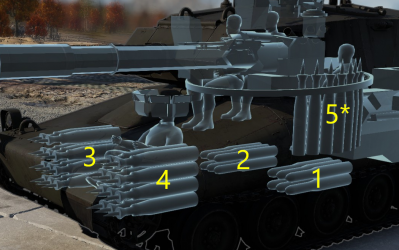
| Full ammo |
1st rack empty |
2nd rack empty |
3rd rack empty |
4th rack empty |
5th rack empty |
Visual discrepancy |
|---|---|---|---|---|---|---|
| 41 | 36 (+5) | 30 (+11) | 19 (+22) | 8 (+33) | 1 (+40) | No |
Machine guns
| 12.7 mm M2HB | ||||
|---|---|---|---|---|
| Mount | Capacity (Belt) | Fire rate | Vertical | Horizontal |
| Pintle | 600 (200) | 576 | -5°/+25° | -120°/+100° |
| 7.62 mm L8A2 | ||||
|---|---|---|---|---|
| Mount | Capacity (Belt) | Fire rate | Vertical | Horizontal |
| Coaxial | 4,600 (200) | 600 | N/A | N/A |
Usage in battles
Describe the tactics of playing in the vehicle, the features of using vehicles in the team and advice on tactics. Refrain from creating a "guide" - do not impose a single point of view but instead give the reader food for thought. Describe the most dangerous enemies and give recommendations on fighting them. If necessary, note the specifics of the game in different modes (AB, RB, SB).
Pros and cons
Pros:
- Equips the renowned 105 mm L7 cannon
- Good mobility
- 10X gunner zoom is good for sniping
Cons:
- Lightly armoured
- Stock HEATFS, a bad thing considering enemies can be well-protected against chemical warheads
- Non-sabot APHE rounds from most SPAA's will ricochet off the hull into the lower turret, damaging or knocking out the turret crew
History
The VFM 5, also known as Vickers Mk.5, was a light tank built by Vickers. It was based on the hull of the American Close Combat Vehicle Light (CCV-L), which was built by VFM, but with a new turret and main armament. It was primarily designed for export.
Development
The CCV-L was first revealed by FMC at AUSA in October 1985. Vickers Defense Systems and FMC formed a cooperative agreement later that year to design an export version of the tank. It had been designed as a cheaper version of the CCV-L, and it was designated as the VFM 5. After the prototype was completed in 1986, it was displayed at the British Army Equipment Exhibition of the same year. No production orders were received.
Design
The hull was nearly unmodified from the CCV-L, made of welded aluminum armour with applique steel armour available for the front and sides.
The layout of the VFM 5 was conventional. The driver was located in the front, the fighting compartment in the center, and the engine compartment at the rear.
The driver sat in the center of the front of the hull. His seat was adjustable, with a folding backrest to allow access to the fighting compartment. His hatch was opened by use of hinges on the rear, and it had five periscopes for viewing to the front and sides. When necessary, the center, forward facing periscope could be replaced with a passive periscope for night operations.
The turret is different from that of the CCV-L. The turret had a crew of three, and it was constructed in the same way as the hull, with welded aluminum armour and applique steel plates. The turret was mounted on a high-accuracy low-friction turret ring that is tilted down 3° at the front.
The main armament of the VMF 5 was a 105 mm Low Recoil Force gun, fitted with an integral muzzle break and a rigid thermal sleeve. 41 rounds of 105 mm ammunition were carried. 22 rounds were stored in the front of the hull, 11 on each side of the driver. 19 rounds were stored in the fighting compartment, located below the turret ring. Unlike the CCV-L, the VFM 5 features a loader, rather than an automatic loading system.
A Marconi fire-control system (FCS) is used, which includes computerized fire-control systems and a two-axis gun stabilizer. The turret traversed electronically 360°, while the gun elevated from -10° to +20°.
The secondary armament consisted of a coaxial 7.62 mm L8 machine gun. A total of 2,600 rounds of 7.62 mm ammunition were carried in boxes of 200 rounds. Additionally, a 7.62 mm or 12.7 mm machine gun could be pintle-mounted at the leader's hatch. 500 rounds could be carried if the 12.7 mm machine gun was fitted.
A bank of six smoke grenade launchers was located on each side of the turret, for a total of twelve smoke or fragmentation grenades. They were fired electronically by the bank's commander from the interior.
The gunner's primary sight was a NANOQUEST telescopic sight with a zoom of x10. It incorporated a laser rangefinder and muzzle reference system. The gunner also had a NANOQUEST periscope for wide-angle observation. A thermal imaging system was available as an option.
The commander had a rear-opening, single piece hatch with fiver periscopes. He also had a Pilkington PE/Raven II day/night sight with magnification of x1 and x8, as well as image intensification for night operations.
The loader also had a single piece, rear-opening hatch with a single AFV No 3 Mk 1 periscope with 360° of rotation.
The suspension of the VFM 5 is a torsion bar type. There are six road wheels on each side of the chassis and a shock absorber at each road wheel. 38 cm double-pin tracks are used.
The engine is a General Motors (GM) Detroit Diesel Model 6V-92 TA 6-cylinder, producing 550 horsepower. A General Electric (GE) HMPT-500-3 transmission is used, with three forward gears and one reverse gear. The powerpack is cooled by a water radiator and oil cooler. Easy access to the engine is provided by a rear hull ramp, which the engine can be slid down for maintenance or replacement. Access covers are located on the engine compartment roof for easy maintenance as well.
The engine compartment is protected by an automatic fire-suppression system, and one can also be fitted for the crew compartment. Handheld extinguishers are also provided.
Devblog
In 1985, Vickers formed a consortium with the American FMC company in order to develop a modern, yet cost-effective light tank for the export market. To achieve this, development and production costs had to be kept as low as possible. As a result, the decision was made to combine the CCVL hull developed by FMC for the US Army's AGS project with a Vickers-built turret, housing a modified low-recoil version of the widely used L7 cannon.
The first prototype was built in 1986 and subsequently revealed to the public at the British Army Equipment Exhibition that year. However, despite its modern equipment, excellent mobility and low weight thanks to the wide use of aluminum alloys, the VFM 5 failed to attract any attention from potential international operators at first.
However, testing and further refinement of the vehicle's design continued into the late 1980's and early 1990's, just at that time negotiations were held with Malaysia to supply the tank to the national armed forces, but it ultimately never came to a production agreement. In the end, only a single prototype of the VFM 5 was ever constructed.
Media
- Skins
- Images
- VFM 5 Devblog Images
- Videos
See also
External links
| Vickers-Armstrongs Limited | |
|---|---|
| Ships | |
| Tribal-class | HMS Eskimo · HMCS Haida |
| Invincible-class | HMS Invincible* |
| Kongō-class | IJN Kongo** |
| Tanks | |
| Light Tanks | VFM5*** · Vickers Mk.11*** |
| Light Tank Mk VI | Light AA Mk I |
| Light Tank Mk VII | Tetrarch I |
| Light Tank Mk VIII | Alecto I |
| Tank, Infantry, Valentine | Valentine I · Valentine IX · Valentine XI · Archer |
| Vickers MBT | Vickers Mk.1 · Vickers Mk.3 · Vickers Mk.7*** |
| Heavy Tanks | Independent**** |
| Export | ▂МК-IX "Valentine" · Vickers Mk.E**** |
| See also | Vickers-Armstrongs Aircraft Limited |
| *Previously Armstrong Whitworth | |
| **Built for Japan | |
| ***Vickers Defence Systems | |
| ****Previously Vickers Limited | |
| Britain light tanks | |
|---|---|
| A13 | A13 Mk I · A13 Mk I (3rd R.T.R.) · A13 Mk II · A13 Mk II 1939 |
| A15 | Crusader II · Crusader "The Saint" · Crusader III |
| A17 | Tetrarch I |
| IFV | Warrior · Desert Warrior (Kuwait) |
| Wheeled | Daimler Mk II · AEC Mk II · Fox · Vickers Mk.11 |
| Other | VFM5 |
| South Africa | |
| SARC | SARC MkIVa · SARC MkVI (2pdr) · SARC MkVI (6pdr) |
| Ratel | Ratel 90 · Ratel 20 |
| Rooikat | Rooikat Mk.1D · Rooikat 105 · Rooikat MTTD |
| Other | Concept 3 · Eland 90 Mk.7 |
| USA | Stuart I · Stuart III |


